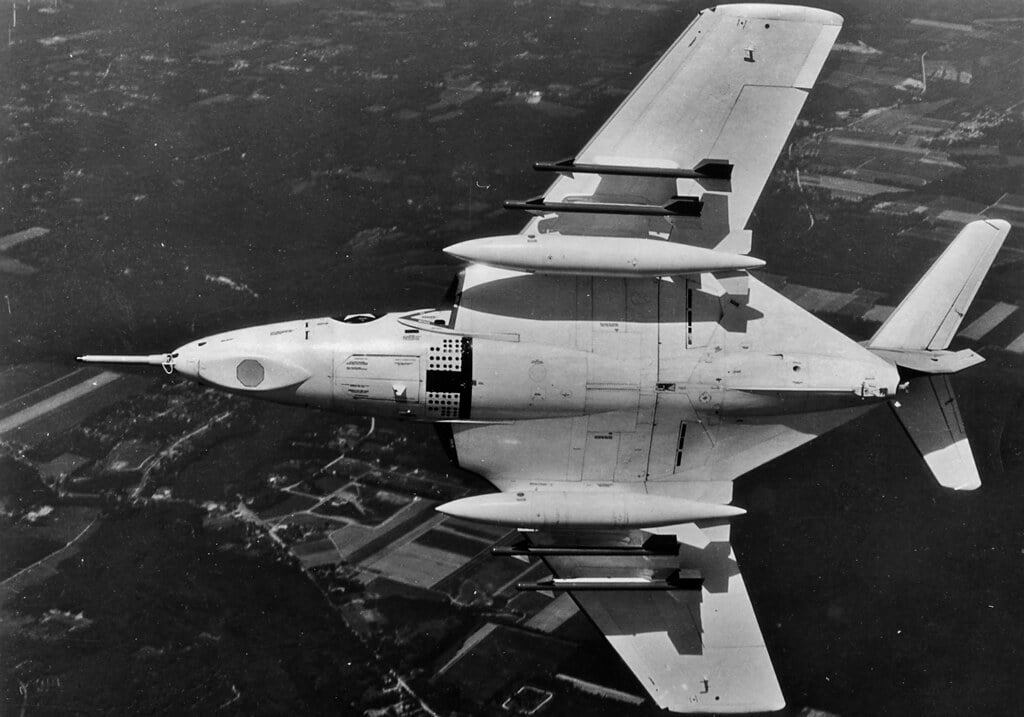The Ultimate Photo Cougar
The 110 F9F-8s modified for photo reconnaissance were designated F9F-8P and were the most distinctive Cougars in appearance. First flown on 18 February 1955, the F9F-8P was equipped with a substantially larger and longer nose than that of the F9F-8 and had a distinct downward “droop.”
It also had flat sides for the camera ports, and housed forward-facing, vertical, and oblique cameras. Internal modifications included elimination of the 20 millimeter cannons, the armament control system, and the AN/APS-30 radar system, the addition of a 12 inch extension to the nose to carry the camera equipment and specialized electronics, reconfiguration of the cockpit consoles to provide controls for the cameras and specialized electronics, and reworked ducting to provide engine-heated air for heating and defrosting the camera equipment. F9F-8Ps were replaced by the Vought F8U-1P Crusader but flew with Navy Reserve squadrons until the mid-1960s.

How Did the Cougar Compare?
When compared to its contemporary swept-winged Navy/Marine Corps jet, the North American FJ-3 Fury, the Cougar had greater endurance, a higher dive speed limit, and could yank and bank at up to 7.5G, whereas the Fury was limited to 6G. The F9F-6 could fly a three-hour combat air patrol (CAP) mission profile on internal fuel- the Fury required external tanks to fly the same CAP hop. The ultimate Fury, the FJ-4, could just manage the same mission. Cougars didn’t deploy quite as many times as Furies did but they were true fighter-bombers. The Furies were fighters first but their ability to deliver ordnance was marginal. Many Cougar pilots reported the Grumman product was easier to fly as well.

Doomsday Cougars
Several F9F-8s were fitted with the Low-Altitude Bombing System (LABS), additional instrumentation, and the control and arming circuitry required for the delivery of “special stores”, AKA nuclear weapons. Designated F9F-8Bs, these doomsday machines were usually flown as standard fighter-bombers equipped with six underwing hardpoints for ordnance delivery. F9F-8s were retired from fleet squadrons beginning in 1958; F9F-8Bs in 1959. Both types served with Reserve squadrons until the mid-1960s, when the boneyards filled up with single-seat Cougars. The Douglas A-4 Skyhawk replaced them in the bomber role. The Vought F-8 Crusader replaced them in the fighter role.

Let’s Build a Two-Seater
The two-seat trainer version of the Cougar, Design 105 for Grumman and designated F9F-8T, took place on 4 April 1956. The forward fuselage was extended by 34 inches to provide space for the second cockpit, with a large single-piece canopy spanning both seats. A windscreen was mounted in front of the rear cockpit, which allowed the jet to be flown with the canopy partially open. A total of 377 F9F-8Ts were produced between 1956 and 1960.

The Flexible Capable Trainer
F9F-8Ts were employed as carrier training, intermediate and advanced flight training, and weapons training aircraft between 1957 and 1974. The F9F-8T retained two of the internal 20 millimeter cannons and the ordnance delivery capability of the standard F9F-8- making it suitable for weapons delivery training. VT-21 Redhawks, VT-22 Golden Eagles, VT-24 Bobcats, and VT-25 Cougars all flew the F9F-8T along with some single-seat F9F-6s and F9F-8s. Many Naval Air Stations had a two-seater Cougar on the flight line used as proficiency trainers. VT-4 Warbucks made the last flight of a TF-9J during February of 1974.

Alphabet Soup
When, in September of 1962, the Tri-Service Designation system went into effect, Cougars were profoundly affected despite the fact that many of them had been retired by then. F9F-6s became F-9Fs. F9F-6D drone controllers became DF-9Fs. F9F-6K drones became QF-9Fs. F9F-6K2 drones became QF-9Gs. F9F-7s became F-9Hs. F9F-8s became F-9Js. F9F-8P photo reconnaissance Cougars became RF-9Js. And F9F-8T trainers became TF-9Js.

